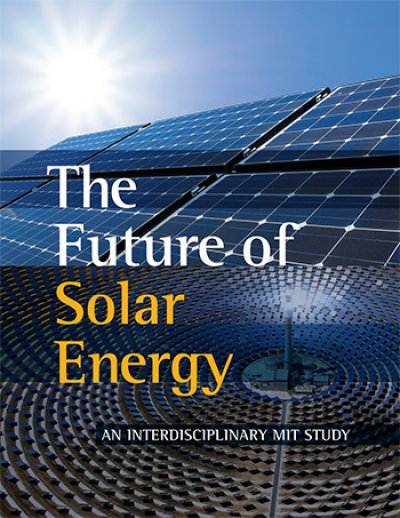 On May 5, 2015, the MIT Energy Initiative (MITEI) released a comprehensive new study titled The Future of Solar Energy. As with earlier installments of the highly regarded MIT “Future of … “ report series, several CEEPR faculty and research affiliates were involved in the elaboration of the study, contributing economic and policy insights to a multidisciplinary, multi-year research effort. Former CEEPR Director Richard Schmalensee, a Professor of Economics and Management at the MIT Sloan School of Management, served as the study’s chair.
On May 5, 2015, the MIT Energy Initiative (MITEI) released a comprehensive new study titled The Future of Solar Energy. As with earlier installments of the highly regarded MIT “Future of … “ report series, several CEEPR faculty and research affiliates were involved in the elaboration of the study, contributing economic and policy insights to a multidisciplinary, multi-year research effort. Former CEEPR Director Richard Schmalensee, a Professor of Economics and Management at the MIT Sloan School of Management, served as the study’s chair.
Although it currently provides only 1% of electricity generated globally, solar energy is seen to enjoy a bright future in the 332-page study. No other technology, its authors say, has the scalability and broad distribution to displace carbon emissions from energy generation by mid-century – an essential element of any serious strategy to mitigate global climate change. “Given the vast resource and its intrinsic zero-carbon nature, it seems inevitable that solar is going to play a key role in future energy systems”, said MITEI’s Director Robert Armstrong during a launch event at the National Press Club in Washington DC.
But the study also identifies serious obstacles on the path towards greater solar penetration, both in terms of technological innovation and enabling regulatory frameworks. Across the study’s ten chapters, the authors draw on their extensive discussion of solar technology, its economic and business implications, and public policy challenges to formulate a series of recommendations. Ultimately, they conclude that any policies related to solar energy should focus on one central objective: to build the foundation for a substantial scale-up of solar generation in the near- and medium term.
Solar module prices have fallen dramatically in recent years, although balance of system (BOS) costs – such as the cost of inverters and other hardware, installation, and marketing – have followed less rapidly. Coupled with decreasing policy support in the U.S. and elsewhere, accelerated growth in solar energy is thus not inevitable.
At the launch event, Francis O’Sullivan, one of the study’s authors, cautioned that “the economics of solar face some important challenges.” In particular, renewable energy penetration in competitive electricity markets tends to depress wholesale prices, which also lowers the return on investment accruing to solar investors. According to O’Sullivan, this underscores the need for continued cost reductions: “We need to focus on driving costs lower and lower”.
While technologically mature, the leading technology for solar energy generation, wafer-based crystalline silicon (c-Si), has intrinsic properties that limit its potential for additional cost savings. Due to their thickness, for instance, they require a heavier substrate, affecting BOS costs. Current thin-film photovoltaic technologies offer opportunities to significantly reduce system costs, but many rely on scarce rare-earth elements, constraining their scalability. Instead of focusing on incremental cost reductions in conventional photovoltaic technology, public research and development efforts should therefore target transformative thin-film technologies that use safe, abundant materials and promise flexibility and low weight.
In another key recommendation, the study calls on public authorities to prepare for a variety of technical and economic challenges raised by growing penetration of variable solar generation. As the share of photovoltaic electricity increases, its ability to replace non-solar generation capacity diminishes, at the same time requiring a higher ramping rate from conventional electricity generation fleets. Diurnal and seasonal changes in solar energy output are predictable, moreover, but hourly photovoltaic electricity output varies with weather and is therefore imperfectly predictable. Finally, while distributed generation can lower line losses, the investments needed to maintain power quality in the distribution system outweigh such savings with growing penetration levels. All this suggests a need for large-scale energy storage, and thus for substantial innovation efforts to reduce the cost of storage technologies.
Unsurprisingly, the challenges of integrating an expanding share of solar photovoltaic generation also extend to the policy arena. Net metering, a widely used policy to support distributed solar energy, favors residential photovoltaic deployment by offering retail rates for generated electricity. Because retail rates bundle the cost of electricity with distribution network and other costs, however, they are considerably higher than the wholesale rates typically available for electricity from utility-scale installations. Also, net metering shifts network costs to ratepayers without renewable energy generation capacity. “The cost shift is real, and that cost shift is going to produce a backlash against distributed generation,” Schmalensee warned at the study’s launch.
Net metering is only one of an extensive portfolio of measures adopted at the federal, state and local levels to support renewable energy. Given the absence of a price on carbon emissions, the study concedes the importance of continued policy support to build experience with manufacturing, deployment, and ways to overcome institutional barriers. By reducing BOS costs, current subsidies can help lay the foundation for an accelerated scale-up of solar energy as technologies improve and become more competitive. Still, because of their focus on investment rather than output, current subsidies – such as the federal investment tax credit and accelerated depreciation opportunities – favor the most expensive sources of solar electricity. Likewise, renewable portfolio standards enacted in a number of states impose siting restrictions on eligible generation, limiting the flexibility to deploy solar photovoltaic technology in locations with the most abundant solar resources. A reform of current subsidy mechanisms should therefore ensure greater solar generation per dollar of subsidy investment – as Schmalensee put it, “if we are about generation, we should reward generation.”
The full report is available at http://mitei.mit.edu/futureofsolar
(May 2015)


